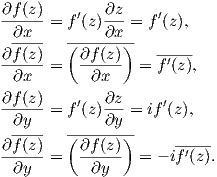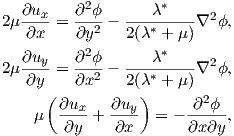
To derive the Kolosov-Muskhelishvili formulation it is necessary to introduce a new function,
known as the Airy stress function. By using the stress-strain relations (2.46) together with the
equilibrium equations (2.43) and the compatibility equations (2.45) described in
 | (A.1) |
where the
 | (A.2) |
The Airy stress function
 | (A.3) |
By using the relationships (A.3) in the equilibrium equations (2.43) it is possible to demonstrate
that the equilibrium conditions are automatically satisfied by
 | (A.4) |
where
Secondly, the Kolosov-Muskhelishvili method is formulated by describing two-dimensional
elastic problems using analytic functions of complex variables. We define the position
representation by the complex variable
 | (A.5) |
where stands for the complex conjugation. (A.5) can also be described using the Cartesian
coordinate system
 | (A.6) |
A function of the complex variable
 | (A.7) |
is said to be analytic at a point
To obtain the complex potential representation of the Airy stress function we introduce a
function
 | (A.8) |
where
 | (A.9) |
Due to the definition (A.4)
 | (A.10) |
where
 | (A.11) |
The complex representation of the Airy stress function requires a further function
 | (A.12) |
which is also analytic and its derivative corresponds to
 | (A.13) |
By considering the
 | (A.14) |
which allows us to obtain a relation between
 | (A.15) |
By using these relations we can rewrite (A.8) as
![∇2 [ϕ- (xp + yq)] = 0,](Main1201x.png) | (A.16) |
where
 | (A.17) |
By employing the relation
 | (A.18) |
the complex potential representation of the Airy stress function is obtained
 | (A.19) |
If we define
 | (A.20) |
summing these equations, we obtain
 | (A.21) |
Equation (A.21) is employed in the next section to derive the Kolosov-Muskhelishvili formulas.
By using the definition of the Airy stress function (A.19), the stresses can be described by
 | (A.22) |
For an analytic function
 | (A.23) |
The differentiation of (A.21) with respect to
![∂ϕ -- ----- ----- -----
2 ---= zψ ′(z)+ ψ (z)+ χ′(z)+ zψ ′(z)+ ψ (z)+ χ′(z),
∂x [ ----- ----- -----]
2 ∂ϕ-= i zψ ′(z)- ψ (z)+ χ′(z)- zψ ′(z)+ ψ (z)- χ′(z) ,
∂y](Main1215x.png) | (A.24) |
where the second equation multiplied by
 | (A.25) |
The equations from (A.22) can be rewritten using (A.25)
 | (A.26) |
The sum of these two equations results in
![[ ----] [ ]
σxx + σyy = 2 ψ′(z) + ψ′(z) = 4Re ψ′(z )](Main1220x.png) | (A.27) |
and the subtraction of the first equation from the second produces
 | (A.28) |
Taking its complex conjugated results in
![[-- ′′ ′′ ]
σyy - σxx + 2iτxy = 2 zψ (x )+ χ (z) .](Main1222x.png) | (A.29) |
The two equations (A.27) and (A.29) are the complex potential representation of the stresses.
Further we derive the complex potential of the displacements. (2.44) and (A.3) can be substituted in (2.46) to give
 | (A.30) |
where
 | (A.31) |
and
 | (A.32) |
and
By plugging
 | (A.33) |
into (A.30) we obtain
 | (A.34) |
which by integrating leads to
 | (A.35) |
where
 | (A.36) |
and recalling (A.25) we obtain
 | (A.37) |
which represent the complex potential of the displacements.
The Kolosov-Muskhelishvili formulas are given by the equations set (A.27), (A.29), and (A.37).